WindForge Review
The sky's the limit, but this one drops like a stone
Today, partially in the interests of transparency but mostly for the sake of easing into this review via a healthy dose of juxtaposition, I'd like to provide a little insight into how I lay the groundwork for the thinly-disguised rants that you see here every few weeks or so. The normal course of action, you see, is to buy a game that looks interesting, download it, play it for a few hours and think “Hmm, this isn't very good. Now, why is that?” However, things progressed somewhat differently for Windforge. First and foremost this is because I hadn't heard even the slightest whisper of its existence until it was deposited, swaddled in rags, on my doorstep by a mysterious cloaked stranger. The second difference occurred when I played it, at which point I thought “Hmm, this isn't very good. So why am I still having fun?”
Windforge is, mechanically at least, a Terraria clone, but only in the sense that it straddles the same line that Doom clones and GTA clones once edged their way over, maturing into genres of their own once people realised that there was enough potential for variety in them. You can do all the things befitting of a Terraria clone, and to be fair you're never strictly obliged to go beyond that if that's really your thing, but the game will certainly make its fair share of meaningful coughs if you don't. Do you really want to sit on this floating island and spend another hour furnishing the upper dining hall? There's a big world out there, you know. Steampunk adventure! Action-RPG elements! A generic half-baked story!
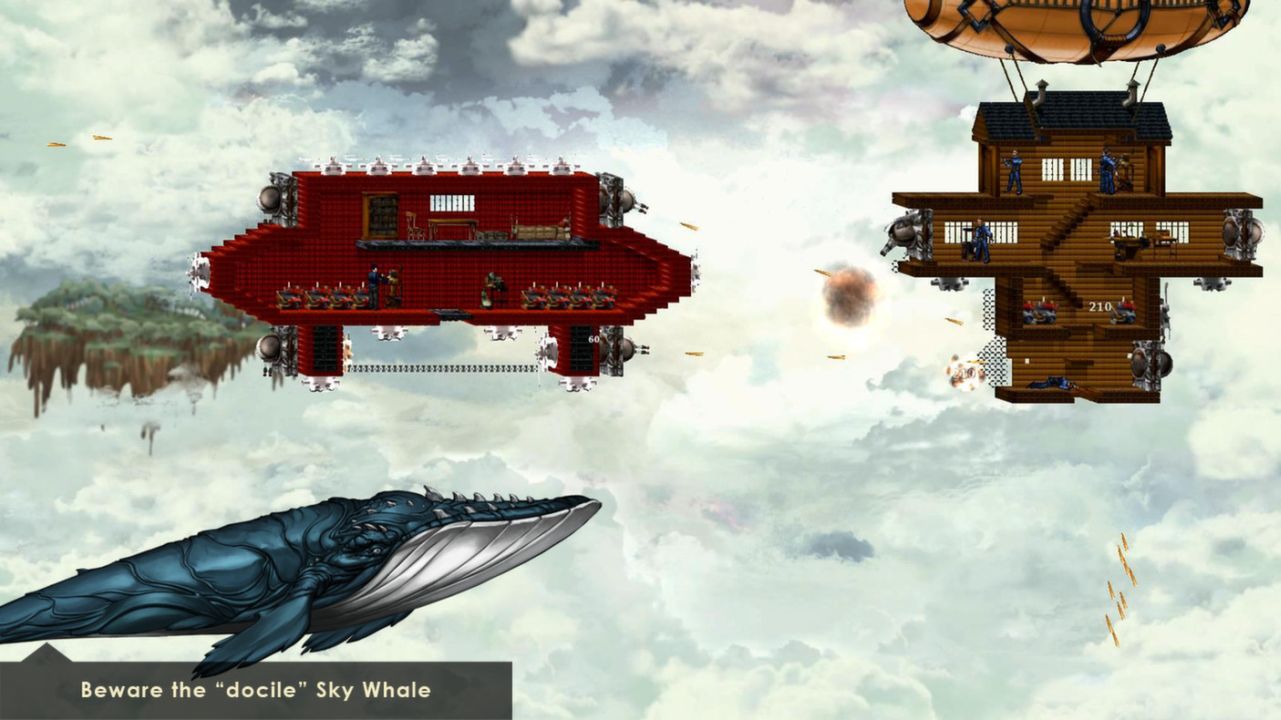
Alright, let's be fair here: I mean 'generic' for a steampunk story, which is still something of a breath of fresh, oil-tinged air in the grand world of videogame storytelling. You, the protagonist, live in a world where the ground has had quite enough of gravity's incessant ordering around and has taken to the skies in the form of a thousand or so floating islands, on which humanity lives and does all the things to be expected from a steampunk society: fly around in airships, refuse to explore the benefits of electricity, wear just a bit too much brown leather, and so on. Unfortunately, nobody noticed the inherent difficulties in starting an industrial revolution when any coal mine more than a few hundred meters deep inevitably becomes a bottomless pit, so the fuel of choice for this burgeoning, fragmented society is the oil and grease harvested from the majestic sky whales. With these creatures fast-approaching extinction the race is on to find alternative energy sources, and while the solution probably resides in those ancient magical energy-producing MacGuffins that are scattered throughout the world, research into them is sadly forbidden thanks to the influence of a widespread influential religious group that might as well be called Antagonisticism. Consequentially it's up to you and a small underground research organisation to recover and investigate these artefacts, saving the developing world from the one fate worse than destruction: unreasonably high petrol prices.
But what of the 'half-baked' part of my dismissive statement? Well, when you introduce a tighter story focus into a game like this, you really have to step up the storytelling itself, and Windforge sort of flops in that regard. None of the characters you interact with are ever developed or even properly introduced. Who are these people? Why should I care about them? If I go and do enough quests will they stop recycling the same three or four dialogue interactions? Nobody is really introduced and they certainly aren't developed; the game just acts like you've always known them and never steps beyond there. I dare say that is true for the character whose actions I'm controlling, but I, the player, do not. It feels like a very old-fashioned RPG, one where nearly everybody is either a vendor or a quest-giver or an enemy to be murdered. Furthermore, in spite of my little dig in the previous paragraph, I'm twelve hours into the game and I've yet to be introduced to a main antagonist yet, which really dampens my enthusiasm. Why do you think Half-Life 2 had Doctor Breen?
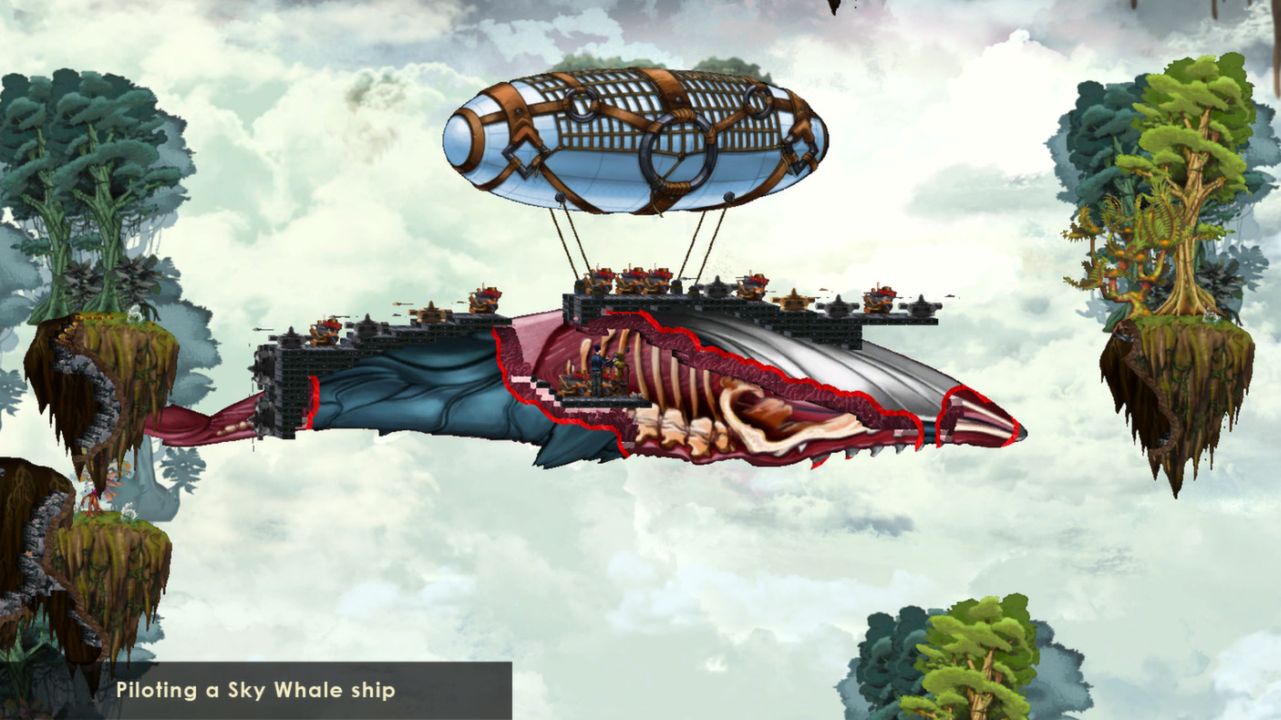
Now, as any advocate of good game design will tell you, the best examples of story and gameplay are ones in which the two both contribute towards one another, in which the gameplay drives the story and the story subtly directs the gameplay. In Windforge, however, the story and gameplay are in a near-constant slap fight where at any given time they could totally contradict each other. Riddle me this, Windforge: why on earth should I care about the demise of the sky-whales and their related supply of oil when you have already demonstrated that every engine, machine and device in this steampunk universe runs on infinite supplies of S-grade fairy dust? Nothing consumes resources of any kind to operate. In a story centred around locating alternative energy sources, it seems extremely silly that you, the player, are immune to any of the actual troubles inherent in this crisis. What's that buzzword? The Bioshock one. You know, the one that every games journalist and their pet goldfish couldn't shut up about because it was the first new idea that had entered their sphere of knowledge in just under a decade. Anyway, it's all the more disappointing considering that I can't think of a good reason why this couldn't have been a gameplay mechanic. The sky-whales are in the game, and you can even kill them if you're heavily-armed enough, but there's no real reason to unless you're a spiteful tosser with a grudge against Greenpeace or you desperately need to fulfil a bulk order for five hundred blubber steaks. Being forced to hunt and harvest one in order to fuel the machines for your next big expedition would have complemented the story and added an extra layer of resource management to the gameplay that could have really made it stand out. But no, magical fairy dust diesel engines it is.
If you're one of those fortunate people to whom the words 'Terraria clone' mean absolutely nothing, either because you've recently emerged from a few years in an experimental cultural isolation tank or because you are an old person who has discovered this article while looking for Yahoo Mail, Windforge is another game in which a lone player character demonstrates the overwhelming destructive power of urban development. You obliterate more trees than a summer bushfire, dig unfeasibly large holes, extract every possible ounce of minerals from them, construct machines and monuments to your grandeur all while increasing your technological capabilities via the crafting system. You can tear through just about anything with your all-purpose steampunk jackhammer – including enemies, as I discovered with a sadistic chuckle of joy – which doesn't degrade or break, while crafting is done by acquiring the recipe, reading it over and going off on a shopping trip to find the necessary materials. It sounds like a logical system but actually getting your hands on recipes is something of a troublesome task. Supposing I want the recipe for a Metalworking Station, a device that would allow me to craft various machines and crucial airship parts, without which I would be severely limited in my crafting potential. I can run down to the local shops and see if they stock the recipe – unlikely, because in the grand tradition of general stores in every RPG ever, their shelves are essentially full of lint, spiders, and stuff you can just find lying around on the street – or I can go get a butcher's knife from the kitchen drawer, slaughter a live rat on my keyboard, offer the entrails as a sacrifice to the gods of random number generation and hope that I can get lucky while looting a bookshelf somewhere in one of the game's population centres.
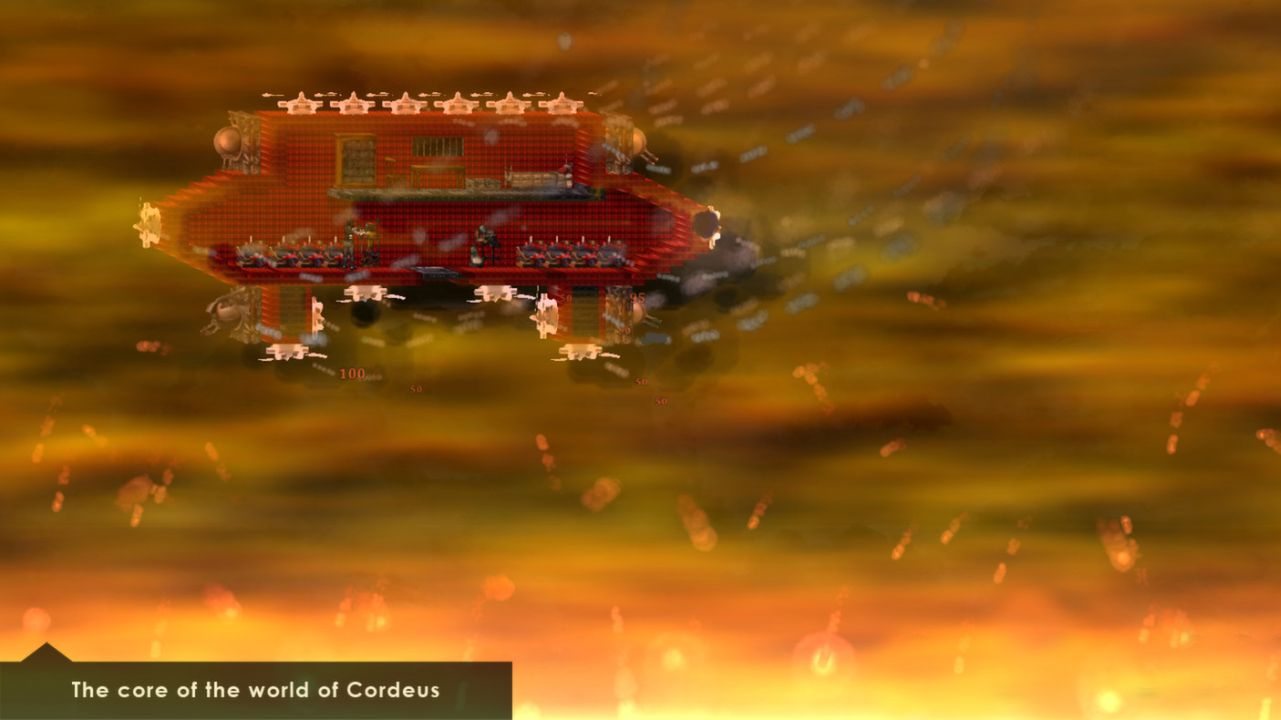
Getting from place to place is difficult in a world where the daily commute involves traversing several miles of empty space with only the occasional updraft to support you, and this being a steampunk game that obviously means the introduction of airships. Now, this is the point where Windforge communicated to me that it's at least trying to lift itself above the bog-standard slew of Terraria clones, not just because it lets you fly around and gun down the local fauna but because its airships, like the terrain around them, are made entirely out of placeable items and blocks. Initially you might just see this as a nice little feature to appeal to your inner builder, allowing you to construct airships shaped like Concordes and cruise liners and male genitalia, but requiring you to maintain the various systems that keep them aloft and leaving the terrain's destructo-physics in really adds a whole new dimension to the gameplay that's just ripe for all kinds of organic chaotic action. You might clip a low-hanging rock while steaming along and burst your balloon, causing your ship to drop out of the sky and leaving you to wrestle with the controls in the vain hope that you'll land on something soft. You might sustain a stray artillery shot to the engine bay and be forced to leap astride an enemy vessel, brandishing a jackhammer and a bowie knife, while your crippled flagship goes up in flames. You might – as I did – get tangled up in a bandit's schooner, ram the resulting barely-buoyant mess of wood and tangled rigging into a cliff-side, and then be forced to tear through your own hull in order to get to your still-living opponents, painfully aware that every sudden movement is causing the wreckage of both your ships to slide a few inches further down the cliff towards a hole so deep that the people at the bottom still think fire is a pretty neat idea. All of this is made that much better by the inclusion of a grappling hook, which – unlike in a certain other game I covered recently – grants enormous freedom of movement once you learn to use it properly. 'Swashbuckling' is absolutely the right word.
And then, with a single terrible swing, Windforge strikes a massive blow against this, its greatest strength. Have you perhaps been wondering how exactly I managed to end up in such awkward situations? Was I not more careful when entrusted with such a precarious and easily-damaged method of transport? Well yes, I initially was, and I imagine I would have stayed that way if my character hadn't sneaked off to a Planetside 2 server while my back was turned and nicked an engineer's repair tool. You can, without any penalty or consumption of resources whatsoever, quickly fix anything man-made in the entire game, and with that kind of power in your hands most of the challenge of airship combat simply evaporates. You could be standing on top of a pile of smouldering timbers, tattered cloth and scrap metal that, with just a few quick sweeps from the repair tool, will miraculously reform back into a functioning escape vehicle in seconds. There's no reason to exercise caution when there's little to no penalty for failure. Couldn't you have contrived some elaborate reason for this repair tool to run on money, Windforge? I would have teased you, for sure, but it's better than this. Or, if that isn't an option, you could have made it so that the repair process isn't so rapid that I can get shot out of the sky and still return my vessel to pristine condition before I even hit a tree. This is another situation where my patented 'whale oil as a tangible resource' game mechanic would have worked nicely.
Actually, now that I reflect on it, you're far more likely to encounter a loading screen than an obstacle while you're speeding towards your impromptu date with the planetary core, and I was meaning to rag on this so I suppose this is as good a time as any. Part of what builds the atmosphere in other procedurally-generated games like Minecraft or Terraria is that – barring the occasional trans-dimensional portal – there are no loading boundaries. Everything seamlessly unrolls beneath you, giving the illusion of a huge unbroken world that does wonders for creating a sense of scale and majesty as you hammer together your first crude wooden hut. By contrast, Windforge's map is divided into a finite grid, where each cell represents an area and each grid line represents another excuse to get up, stretch, and grab another biscuit from the pantry. It can get terribly flow-breaking, especially when you're trying to travel across the map quickly and you end up with a trip that's sixty percent actual flight and forty percent waiting for the next area to load.
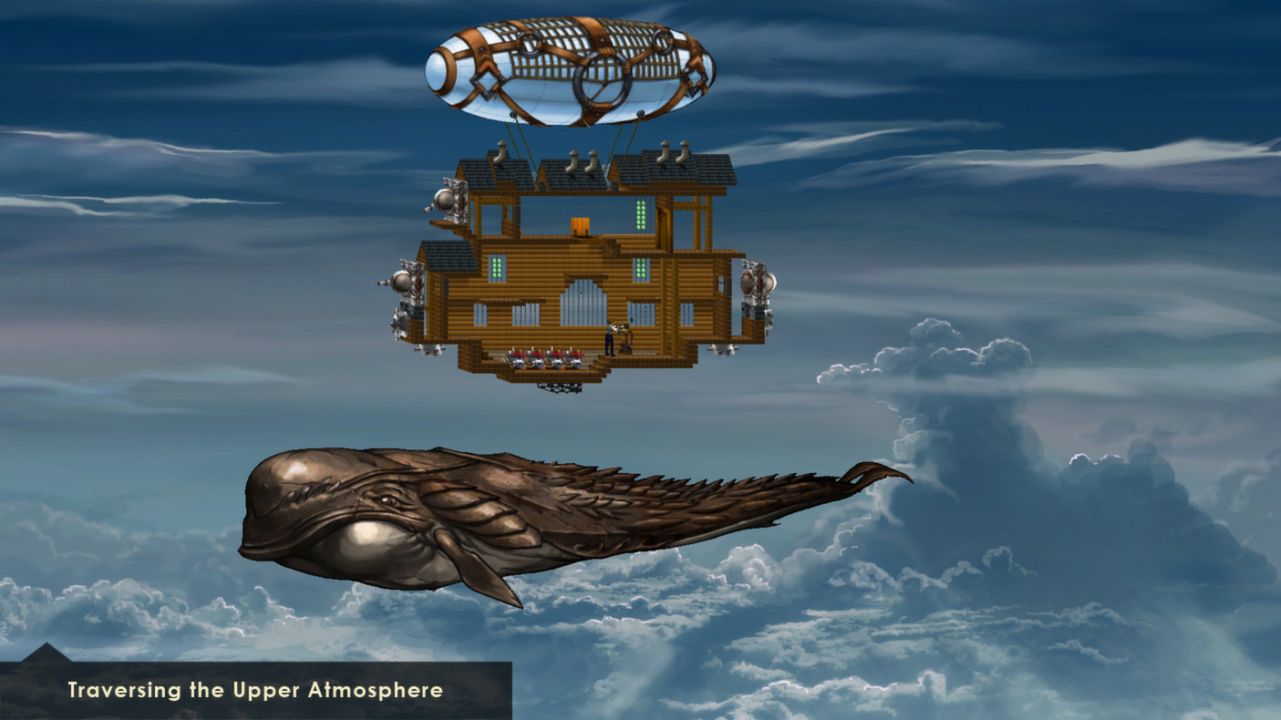
The thing about Windforge is that it has very obviously taken a sizeable step forward from its inspirations, which is a pleasing thing to see, but it seems to be out of stride because not all of it seems to have moved forward at the same time. In spite of the game's pretensions to being part-RPG, the actual business of levelling your stats is a bit unusual and somewhat marginalised. You automatically gain various perks once a stat reaches a certain level – double jump at agility level 20, more health recovered from food at vitality level 20, etcetera – which is a bit simplistic but at least offers some interesting incentives to level up. Much more bizarre is the complete omission of experience points. If you want to level up – and you will, because the story quests tend to seriously pile on the enemies – you will need to brew various magical potions that will arbitrarily increase certain stats once consumed. Even better, the central ingredient in these potions is a rare item found only from defeating bosses and looting temples, so grinding is essentially impossible. Now see here, Windforge: I hate grind. I loathe the idea that I should have to repeatedly complete a boring, unsatisfying task for the sake of overcoming an obstacle. I am absolutely with you on your philosophy here. However, sometimes grind is necessary. What am I supposed to do if I find myself totally overwhelmed when faced with the next big story quest? Like it or not, RPGs need grind, even if it's just a safety net for terminally-thick players like yours truly.
Of course, in a normal action RPG the general understanding between the player and the game is that the player will be able to overcome their inferior levels with enough gumption, skill and cheesing ability – see also, the complete finger-chewing nutters who do level 1 Dark Souls runs – but this rather relies on the game actually having some nuance and skill to its combat mechanics, which sadly isn't quite the case: you can jump, crouch, and shoot. If you happened to put on your fancy pants this morning then you can try grappling to higher ground or digging yourself a hidey-hole, but it's usually an impractical solution when the simple art of 'pressing the trigger until everything in front of you dies' works just fine. Bullets fly slower than an overweight pigeon and have roughly the same level of impact when they hit something, making an actual shoot-out about as involving as lobbing wads of mud at each other. That's before you get to the fights with the local wildlife, where half of the mud you lob at them ends up missing entirely because they have about three animation frames that they jump erratically between like a flip-book with most of the pages torn out.
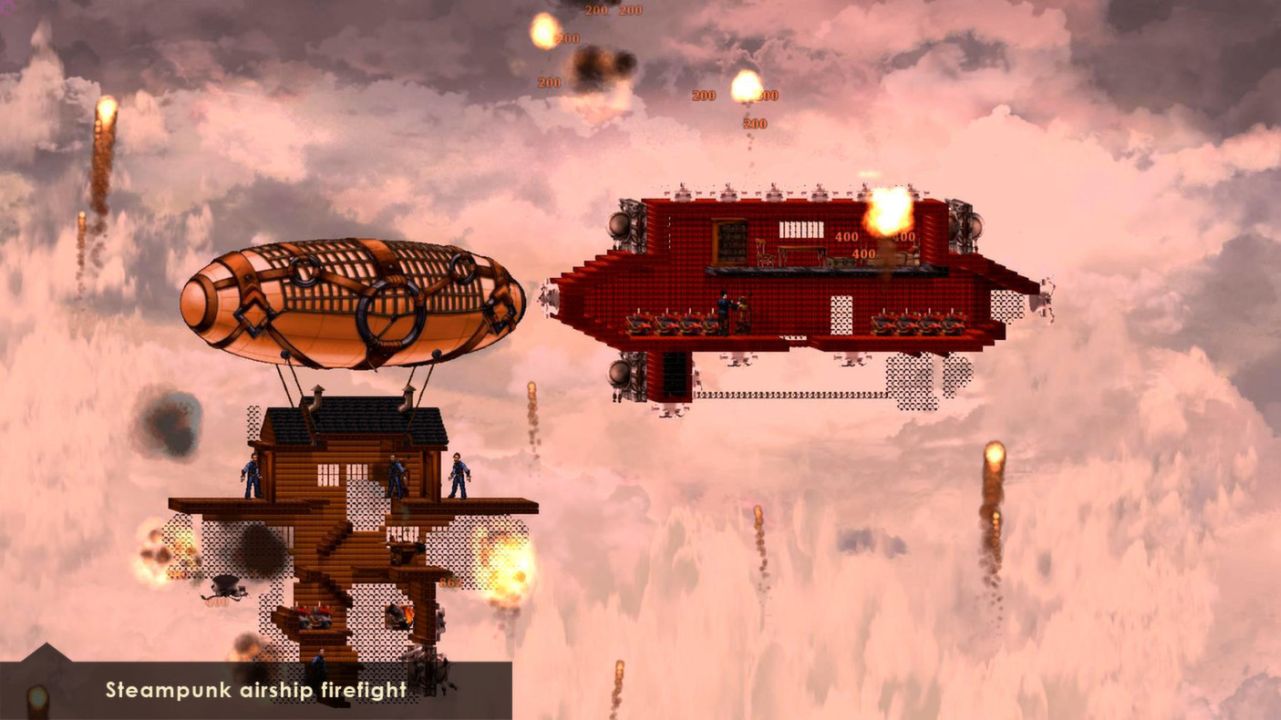
Poor animations are just one of the signs that Windforge is suffering from a severe polish deficiency. It's all very well saying that good gameplay will triumph over a few rough edges, but when you don't appear to have any actual smooth edges remaining on a game that – as we have established – isn't exactly lighting any fireworks to begin with, it becomes harder and harder to ignore. There's a serious dearth of sound effects that becomes particularly noticeable when your enormous four-deck airship with enough heavy armament to powderise an island is capable of taking off and flying without a single peep from its bank of heavy steel propellers. There's no logical point where autosaves trigger, forcing you to rely on a save system that tells you nothing about when or where you made your last save, and the interface has more than a few annoyances too, like the way you can't enter a specific value for items that you plan to craft or trade. Blocks have an effect going on where they project a certain distance into the background, creating an illusion of depth that looks nice in screenshots but makes precision building and mining a nightmare. Often the visuals are so densely packed and lacking in clear design that it becomes hard to tell the difference between a solid ceiling, a specially-formulated platform and a piece of intrusive background art. I suspect that this is, at least partially, the reason why the framerate becomes so atrocious when the game starts rendering anything more complex than a pile of bricks hovering in an empty void. Come on guys, it's not exactly Unreal Engine 4.
Oh, and there are bugs, of course. Hardly a surprise in itself, but Windforge's bugs are of that special variety that seem to be actively spiting you, deliberately piling tragedy upon tragedy. It's not enough for me to get stuck in the terrain, is it? I also have to be catapulted back out, after a brief struggle, with enough speed to instantly splatter me across a cave ceiling. It's not enough that bits of my airship vanish into the ether without rhyme or reason; some of them will have to be entirely replaced instead of being repaired. It's not enough that I have to wrestle with this uninformative minimal save system; the game has to randomly corrupt about two thirds of my save files as well. I pity those people who relied on autosave and discovered one morning that they couldn't actually continue the game anymore. Wait, never mind. That would imply that they were missing out on something.
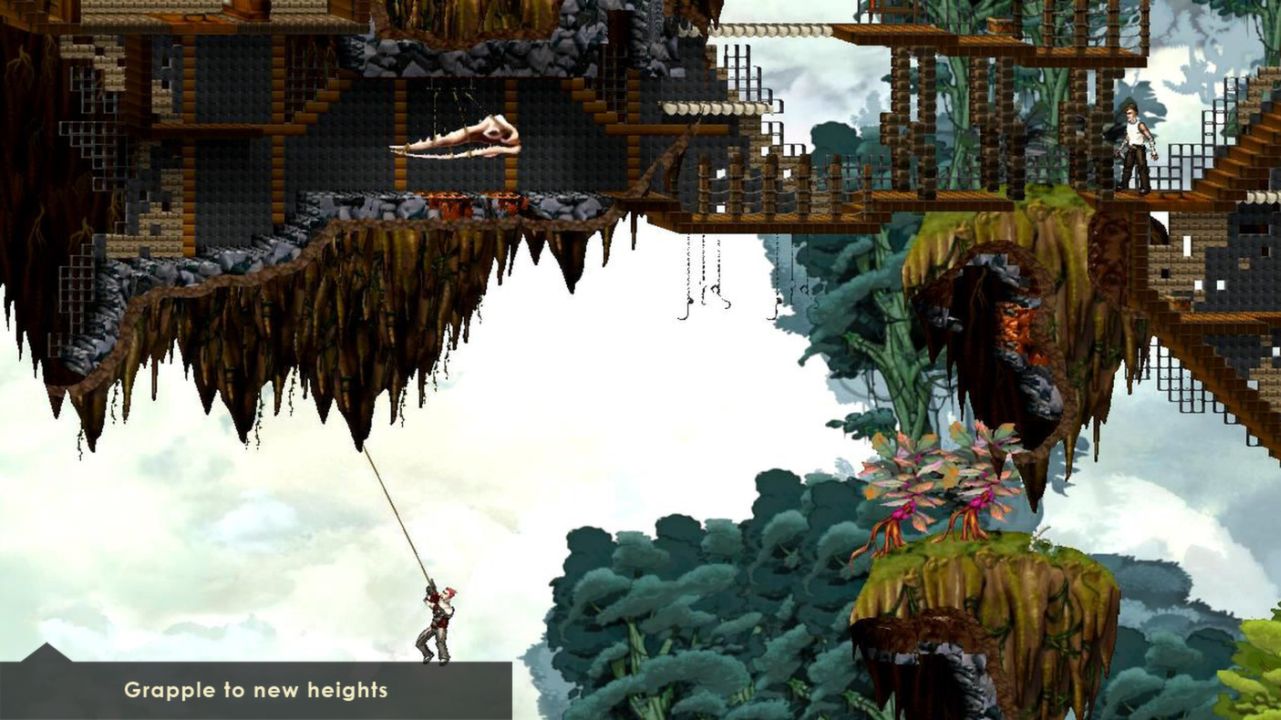
There was a patch, mind. I downloaded it this morning. It broke my last remaining save file, so I suppose that's the end of that.
And yet, as illustrated in the opening paragraph of this exercise in torturous drawn-out whining, there's something senselessly entertaining about Windforge, like riding a rusty bicycle with only rudimentary steering around an overgrown paddock full of bears. The airship combat can be a jolly good time if the circumstances align themselves properly, and if it had been the central mechanic in a polished game that made the most of it then we would have probably had a winner on our hands. As it is, it's a single gem of well-executed innovation resting in the centre of a fetid pile of weak design, and the few brief moments where you see it shining are hardly worth the slog. Windforge is crudely-made, incompetently paced, and broken in all sorts of important ways. You just can't sell it on a single feature after a statement like that, can you?
 Comments
Comments











